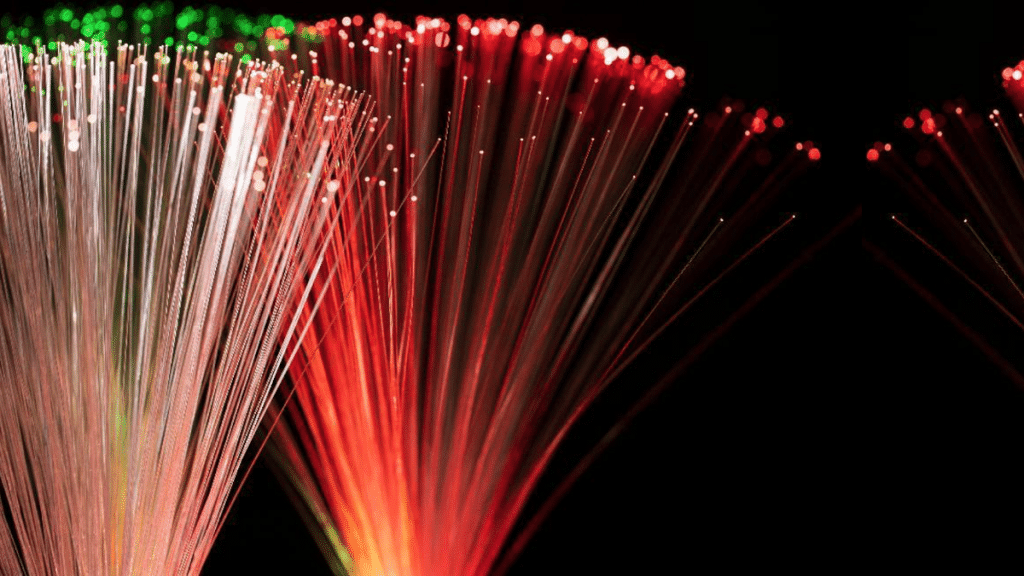Fiber optic cables are crucial for modern communication networks. Their two main categories include simplex and duplex fiber optic cables. While both utilize slim, flexible optical fibers, they differ in construction and operation. Understanding the differences between these optical fiber cable varieties benefits technicians working with fiber installations and problem-solving.
Simplex Fiber Optic Cables: Overview
Simplex varieties feature a single strand of glass or plastic optical fiber and a single outer jacket.
Structure
This type of fiber optic cable consists of a single glass or plastic fiber core. A protective outer jacket or sheath surrounds the core. The core carries transmitted light signals, while the external covering shields the delicate inner fiber from outside harm.
Working Principle
Being limited to one fiber strand, simplex cables unidirectionally propagate signals from one cable terminus to the other in a solitary direction. Transmission is via light pulses encoded with digital data sent through the fiber core from source to destination. The solitary fiber restricts communication to only one transmission path.
Types
There exist two broad categories of simplex cables – single-mode simplex cables tailored for long-haul communications and multimode simplex fiber optic cable type solutions applied to short-reach applications utilizing wider-diameter fibers.
Applications
Common applications leveraging the unidirectional properties of simplex cables include cable television broadcasting systems relaying media to subscribers, security monitoring networks transmitting alarm signals inbound, and other one-way transmission linkages necessitating sole signal propagation in a single direction.
Duplex Fiber Optic Cables: Overview
Duplex fiber optic cables comprise a bundled architecture of two individual fiber strands protected by a concentric outer sheath.
Structure
At the core of the duplex optical fiber cable lies a pair of glass or plastic fibers enlisted in a twisting zip-cord arrangement within a coaxial protective jacket envelope. This interior framework incorporates two independent transmission mediums enclosed by a single safeguarding external armor.
Working Principle
Thanks to the two internal fiber cores, duplex cables can synchronously transmit and receive optical signals between end terminals. Each individual fiber independently facilitates inbound and outbound light-borne communications between cable terminals.
Types
Duplex fiber optic cable comes in variants optimized for specific application needs, including single-mode for long-haul networks and multimode for short-reach solutions, as well as half-duplex and full-duplex functionality.
Applications
Duplex fiber cables are primarily used in present-day bidirectional data, voice, and video backbones. These two-way transmission infrastructure building blocks also provide connectivity in networking and telecommunications scenarios requiring concurrent two-fiber transmission capabilities.
Comparison Highlights
This table presents a visual comparison of the key distinguishing characteristics between simplex and duplex fiber optic cables:
| Parameter/Characteristic | Simplex Cable | Duplex Cable |
| Number of Fibers | 1 fiber | 2 fibers |
| Data Transmission Direction | Unidirectional (one-way) | Bidirectional (two-way) |
| Fiber Arrangement | Single fiber enclosed in a jacket | Pair of fibers in zip-cord configuration within a jacket |
| Common Applications | Signal distribution, cable TV broadcasting, security systems | Data networking, telecommunications, network backbones, infrastructure backbones |
| Benefits | Dedicated fiber allows dedicated one-way transmission | Enables simultaneous two-way communication |
| Limitations | Only transmits signals in one direction | it has a slightly bulkier construction than a simplex cable |
Products Highlight: FAB-GJFJV/H and Flat Twin Duplex Tight Buffer Cable
Weichuang Optics is a seasoned manufacturer of optical fiber cables and connectors. It supplies high-quality optical fiber optic cable solutions adhering to ISO 9001:2015 international standards. With state-of-the-art facilities and reliable management systems, the fiber optic cable supplier offers excellent products and after-sales support. Two of its top offerings include:
FAB-GJFJV/H Simplex Cable
This simplex optical fiber cable features a tight buffer fiber coating for enhanced strength. Its top characteristics include:
- Tight buffer fiber coating of 900-micrometer thickness protects the glass fiber while maintaining its flexibility. The tight buffer coating enhances the cable’s tensile strength to withstand stresses.
- Flame-retardant jacket material extruded around the tight buffer fiber core meets stringent fire safety standards, protecting installed networks.
- Come with 8.3/125 single-mode and 50/125 or 62.5/125-micron multimode fiber types according to application needs for long or short-distance networks.
Flat Twin Duplex Tight Buffer Cable
This duplex cable contains two independent tight buffer fiber cores bundled together within a single protective jacket. The key features that make it a top choice include:
- Dual independent tight buffer fiber cores each support single-fiber transmission in opposite directions for full-duplex communication capabilities.
- Flat shape and profile take up less space in underground conduits or overhead lashed aerially compared to round cables.
Conclusion
Overall, simplex and duplex fiber optic cable varieties serve different communication needs based on their single or dual fiber core configuration. Simplex facilitates one-way transmission applications, while duplex enables full bidirectional capability. As a premier fiber optic cable manufacturer, Weichuang Optics offers high-quality solutions for both cable types. Its reliable products meet various connectivity needs with superior performance and support. Visit Weichuang Optics’ website to browse all of its offerings.

